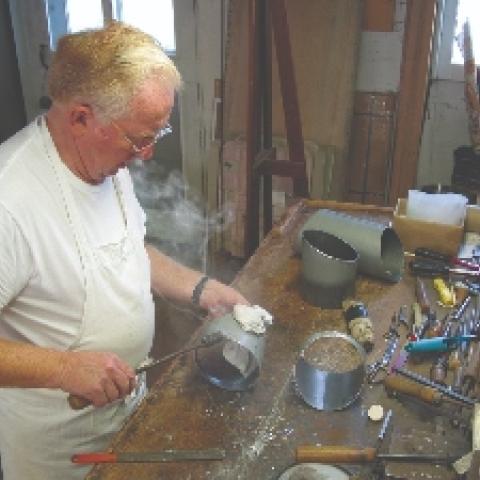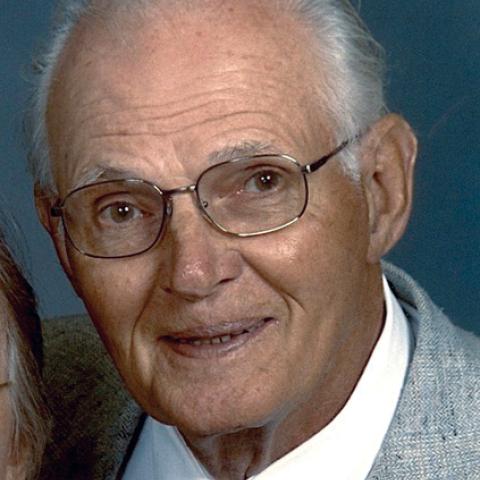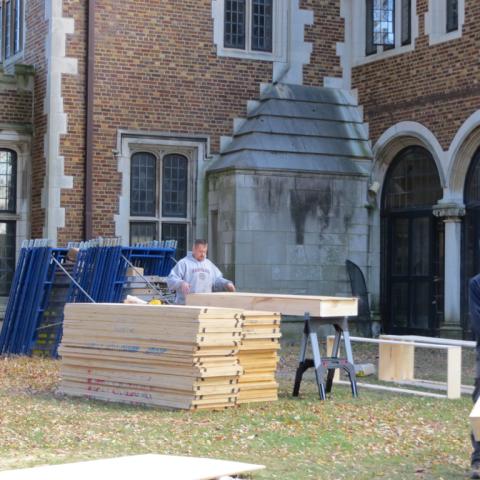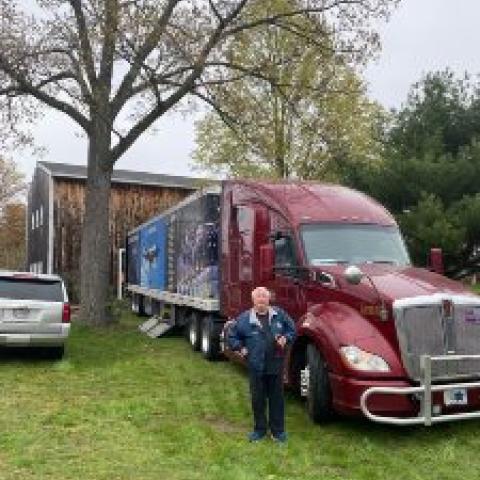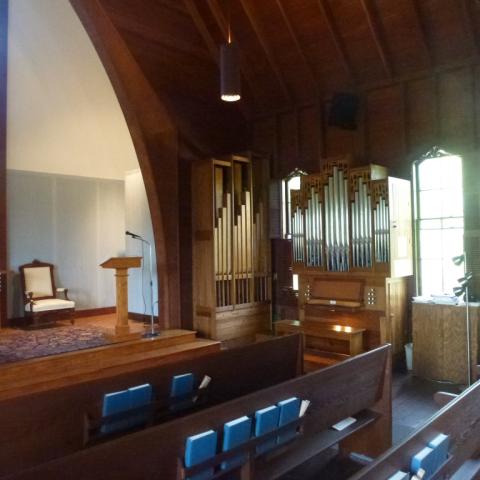
On the road again
In April 2021, after a year of Covid isolation and after I received my second dose of the vaccine, I went on a “bust out” road trip driving south from our home in New York City as far as Atlanta, visiting three colleagues’ organ shops, the installation of an organ where the Organ Clearing House crew was working, and a few iconic instruments. It was my reintroduction to the excitement of being out and about, seeing friends and colleagues, and getting my nose back in the business after being sequestered at our place in Maine during the worst of the pandemic. I wrote about that trip under the title “On the road again” in the July 2021 issue of The Diapason (pages 10–11). It was fun to recreate and chronicle some of my experiences on the road, and here I am to do it again.
Last week I drove as far west as Chicago from our new home in Stockbridge, Massachusetts. Two things inspired this trip. The Organ Clearing House was installing a relocated organ by Gabriel Kney (Opus 93 from Dallas, Texas) at the Saint Meinrad School of Theology in Saint Meinrad, Indiana, and I was promoting an exceptional organ built by M. P. Möller (Opus 5881 from Chicago, Illinois) that had been donated by organ historian and architect William H. Barnes and his brother and mother in honor of his father, Charles Osborne Barnes, who had been a longtime member and trustee of the church.
I was on the road for seven nights, stayed in five different hotels, and drove just over twenty-five-hundred miles. I love that kind of driving. My first experiences with long-distance driving were as a student at Oberlin when I drove back and forth between school and home in the Boston area, growing familiar with Interstate 90. During the summer of 1978, just after my graduation from Oberlin, my mentor John Leek and I drove to Oakland, California, to deliver a harpsichord we built. That trip was a great lesson about our country because while it is a one-day drive from Boston to Oberlin, it is a five or six-day drive from Oberlin to San Francisco. Just as I thought I was going west when I went away to school, a school friend who grew up in northern Wisconsin thought he was going south.
Kegg Organ Company
I left home on Saturday morning, spent that night outside Cleveland, met my friend Charles Kegg for breakfast on Sunday morning in Hartville, Ohio, and visited his workshop, which is in a 16,500-square-foot building, beautifully equipped for the specialized work of building pipe organs. The immense rooms are carefully planned and nicely maintained. There is a fleet of orderly stationary machines and workstations. Various components and structures of a large organ under construction occupied big areas of the abundant floor space. The company had just upgraded the HVAC system to include air filtering, heating, and air conditioning, replacing the noisy old hanging gas heaters of yesteryear.
I was especially interested to see one of Charles’s specialties and passions, the machine built by M. P. Möller to produce rolls for their automatic organs. It is a stately structure with an intricate mechanism that transfers musical notes into holes in the paper rolls. Möller rolls are big and heavy, a large-format version of the more familiar Aeolian rolls. Charles was working with the now-shuttered American Organ Institute at the University of Oklahoma to rejuvenate the machine and make new rolls to aid in the understanding of that brilliant technology developed early in the twentieth century. Along with his active interest in automatic musical instruments, Charles and his company are building beautiful new organs with electric-valve actions, versatile symphonic specifications, and exquisite consoles.
Saint Meinrad School of Theology
I left Hartville to drive across Ohio, through Cincinnati and past Louisville, Kentucky, to Saint Meinrad, Indiana, the town next to Santa Claus near the southern tip of the state. Saint Meinrad is a thriving Catholic seminary on a beautiful remote campus. There is a prominent archabbey with an organ by Goulding & Wood in the principal chapel, and the school operates industries that produce high-quality caskets and peanut butter.
In addition to the archabbey there is a chapel honoring Saint Thomas Aquinas, where the Organ Clearing House was installing an organ built in 1980 by Gabriel Kney (Opus 93) for the First Community Church of Dallas, Texas. Susan Ferré was the consultant for the design and construction of the project. Debra Dyko, the theological school’s organist, found the instrument listed on the OCH website and went to Dallas within a week to audition the organ. The sale was completed quickly, and less than a month later, the OCH crew was in Dallas dismantling the organ.
I arrived when the installation was well along. The case was up, windchests in place, action connected and functioning, and the wind system was complete. I was able to help connect the solid-state slider control and combination mechanisms including the installation of a new 24-volt DC power supply for the Heuss slider motors. I “retired” from working on-site with the crew at the end of 2019, and it was nice to have tools in my hands again for a few hours. This was a classic relocation project. The organ is well suited for the building visually and tonally. It is well built, so it went back together easily and will be a reliable instrument for decades of further use, and it was a great fit physically and visually—there were no alterations required. Fred Bahr of John-Paul Buzard Pipe Organ Builders accomplished tonal finishing of the organ in May.
. . . and speaking of Buzard . . .
I left Saint Meinrad on Tuesday morning to drive to Champaign, Illinois, to visit John-Paul Buzard Pipe Organ Builders. I had a nice lunch with John-Paul Buzard that included rich conversation about organbuilding philosophies, the history of his company, and conversations about past and future collaborations. The company, affectionately referred to as “Buzco” (as seen on the license plates of company vehicles), is in a former women’s residential hotel in downtown Champaign. It is a four-story building with rental apartments on the fourth floor (The Organ Loft Apartments) and three floors of offices, workshops, voicing studios, and erection space.
A large, four-manual organ for Saint George’s Episcopal Church in Nashville, Tennessee, is under construction, and I saw a big section of the framework and structure of the instrument in the erection space, windchests being assembled, wind system components being built, pipes in the voicing rooms, and the console partially assembled. The long corridors down the center of each floor serve as storage rooms and are wide enough to allow passage between stacks of organ components.
The Buzco service department has a separate workshop in a building across the street devoted to large-scale repairs of organs they maintain. There is a well-equipped woodworking shop, leathering station, stocks of wiring supplies, and lots of projects in progress on workbenches. Keeping renovation and repair work separate from the construction of new organs makes it easier to keep track of things.
I visited with the brilliant organist Katelyn Emerson at McKinley Presbyterian Church where she played for me on the 1994 Dobson Opus 63. We sat in a pew talking for an hour or two about the organ, its music, and her upcoming studies in Britain. Katelyn’s husband, David Brown, is a longtime member of the Buzard shop, a dear friend with whom I correspond regularly. I was delighted to sit between Dave and Katelyn at the rollicking dinner that evening hosted by John-Paul that included his wife and daughter along with several other members of the Buzco team.
Given by the master
William Harrison Barnes (1892–1980) was an authority on pipe organ construction and a consultant responsible for the design of some four hundred instruments. He grew up in the Chicago area and graduated from Evanston Township High School in 1910. In 2008, the high school celebrated the fiftieth anniversary of the three-manual pipe organ that Dr. Barnes donated to the school. His home church was Epworth United Methodist Church of Chicago where his father, Charles Osborne Barnes, was a longtime member and trustee. A plaque on the wall of the church dedicates the 1931
M. P. Möller organ (Opus 5881) to the loving memory of Charles Osborne Barnes, naming the donors as Mrs. Charles O. Barnes and her two sons, William H. Barnes and Harold O. Barnes.
When Pastor Max Kuecker of Epworth Church contacted me about organizing the sale of the organ and shared its history with me, I imagined a scenario in the offices of M. P. Möller when staff members looked at each other and agreed that with the Barnes family involved, this had better be an exceptional instrument, and I was curious to see it. The church had waited until after the proverbial last minute to address the future of the organ as our first contact was after the sale of the building with real estate closing just weeks away. Since our company would be working in Saint Meinrad, I combined the two interests and planned my trip.
The people at Möller did deliver an exceptional organ. There are twenty-two ranks in three manual divisions with one independent pedal rank, 16′/8′ Bourdon, enclosed with the Swell. The Choir division is located across a stairway from the main organ chamber and has shutters facing two rooms. One set of shutters speaks into the stairwell and through a grille that opens into the choir loft, the other opens into the adjacent Sunday School chapel, and the Choir organ is playable as a separate instrument from a two-manual console in the chapel. Each console has a cut-out switch to close and disable the shutters that are not to be in use. An eight-octave rank of flue pipes that starts at 16′ (1–24 stopped, 25–37 open, 38–56 open harmonic, 57–97 metal) sits on a unit chest allowing it to be used as a pedal stop and at different pitches on the keyboards while the ranks of the main pitman chest are distributed between the two keyboards.
There are four 8′ diapasons on the organ, two in the Great and one each in the Swell and Choir, and the Great 8′ Second Diapason is extended as a pedal stop with a marvelous octave of 16′ Diaphone pipes. There is plenty of power, and the Choir 8′ Dulciana and Swell 8′ Muted Viol disappear as whispers when the boxes are closed. You can learn more about this organ here: pipeorgandatabase.org/organ/9216.
When I posted Opus 5881 for sale on our website and promoted it on Facebook, I was not surprised to have immediate responses from congregations interested in acquiring it, and as I planned my trip, I invited the organists of those churches to meet with me while I was visiting the church. I shared the organ with representatives of two churches, one of which was quick to act, and while as I write the transaction is not officially completed, it sure looks as though we will be dismantling that organ in July. I’ll let you know when the deal is complete.
The corner of Oak and Walnut
I left Chicago on Friday morning for the six-hour drive to Orrville, Ohio, where the Schantz Organ Company has been on that street corner for 121 years. Organ architect Eric Gastier greeted me and showed me through the storied workshop where nearly twenty-five-hundred organs have been built, an average of about twenty organs a year. We were joined by Jeffery Dexter, vice president and tonal director, for conversations about the history and operation of the company.
The deep heritage of the company is evident everywhere in the huge shop building. Heavily worn wood floors tell the history of the countless footsteps and cartwheels required to build one organ, not to mention twenty-five hundred. Jigs and patterns for dozens of specialty components hang on the walls, and personal workstations are decorated with family photos and mementos and lifetime tools. There is specialty equipment everywhere like a power-vented workstation for soldering metal windlines, mechanized rollers with crank handles for turning tiny tuning slides, tapered and straight mandrills for shaping organ pipes, and ancient carts for the storage and transportation of hundreds of clamps. There is a huge belt sander, wide enough to accept the largest windchest, and an elegant walnut-wainscoted conference room with raised panels that only an organ shop could build. My tour took us through a seemingly endless maze of rooms, both large and small, each dedicated to a specific facet of the art of making pipe organs.
There are very few workshops remaining in the world in which pipe organs have been built by the thousand. I have visited the shops of Austin, Reuter, and Casavant, but am hard-pressed to think of another North American shop with such a legacy. I think of the thousands of truckloads of organs that have rolled away from the loading dock and down the residential street to Main Street where you can drive across the railroad tracks and find a highway.
Whiling away the time
What do you do while you are driving twenty-five-hundred miles alone? My work with the Organ Clearing House has brought me close to the American trucking industry, as I wrote in the April 2022 issue of The Diapason (pages 10–11). Because we maintain DOT (Department of Transportation) and FMCSA (Federal Motor Carrier Safety Administration) numbers, to Wendy’s amusement I receive several trucking magazines. Glancing at them occasionally, I know that Walmart is America’s largest trucking company. My observation is that Amazon must be becoming a close second—their trucks are everywhere. Landstar, the company we use, has a solid presence on the country’s highways. Taking attendance is a mindless occupation as white lines stream past.
Highway warning signs can be amusing, like the one on I-90 in western New York that says, “Correctional facility ahead, don’t stop for hitchhikers,” or the huge tourist stop and museum in eastern Pennsylvania with a sign that reads, “Be prepared to see more than you expected.” For years I have loved listening to “books on tape” while driving, the concept updated now to Audible.com. As a devoted sailor, I listened to Joshua Slocum’s famous memoir, Sailing Around the World Alone, for the third time. I especially love the moment when he frightens away a pirate attack by scattering upholstery tacks on the deck of his oyster sloop, Spray. I wonder if the pirates got shoes after that.
A couple months ago, Wendy introduced me to a series of podcasts called Sticky Notes hosted by the conductor Joshua Weilerstein, artistic director of the Orchestre de Chambre de Lausanne in Switzerland. In each of the dozens of hour-long episodes, Weilerstein analyzes a different piece of music using many recorded examples, delivered in a rapid vocal cadence. During this trip I listened to his thoughts on the Bach cello suites and Goldberg Variations, Beethoven’s Eroica Symphony, Brahms’s Piano Concerto No. 2, Elgar’s Enigma Variations, and Shostakovich’s Symphony No. 5. I didn’t agree with everything he said (the recording he used of Beethoven’s Eroica was too fast), but I found it engaging to argue with him while I was driving. As an enthusiastic young musician with an impressive career unfolding, Weilerstein has given much thought to the music he performs, and his insights are rewarding, informative, and reminiscent of Leonard Bernstein’s iconic Young People’s Concerts on television with the New York Philharmonic Orchestra. Download the Sticky Notes app, and you’ll see a big library of compelling lessons.
That Ingenious Business . . .
. . . is the title of an authoritative book about the Pennsylvania German organbuilders of the late eighteenth and early nineteenth centuries, written by the late organbuilder Raymond J. Brunner and published by the Pennsylvania German Society in 1990. It reflects a comment by a bystander, a contemporary of David Tannenberg, the greatest of that tribe of craftsmen. I am reminded of that phrase whenever I visit an organ shop. Each of the three shops I visited last week has a distinct personality, an aura that reflects the philosophy of its founder, whether living and active or gone for generations. Each building speaks of the passion behind this fascinating art, and each displays craftsmanship at its Old World finest combined with cutting-edge materials and equipment. My thanks to Charles Kegg, John-Paul Buzard, Eric Gastier, and Jeffrey Dexter for sharing their work with me. I am the richer for it, and I promise I won’t pick up any hitchhikers.

